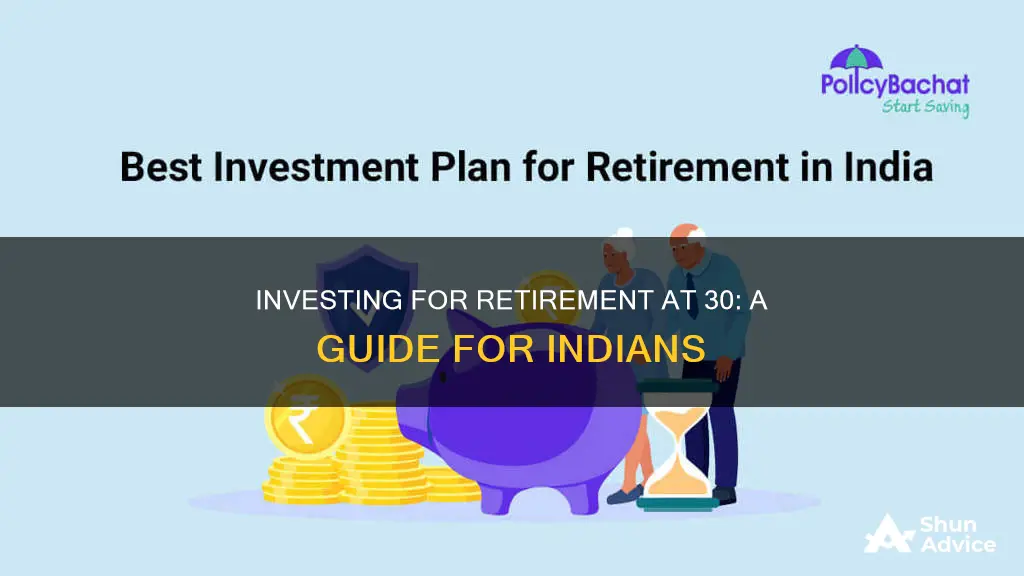
Planning for retirement in your 30s is a smart move that can have a significant impact on your financial security and ensure a comfortable life. It is a good time to start planning for retirement as it is midway to retirement and people tend to have more established careers and higher incomes that can support their families and leave some money to save and invest. This article will discuss how to invest for retirement at 30 in India, covering topics such as setting clear goals, assessing your financial situation, exploring investment options, and adopting disciplined savings habits.
What You'll Learn

Assess your current finances and set clear goals
When it comes to investing for retirement at 30, assessing your current finances and setting clear goals is a crucial step. Here are some detailed instructions to help you through the process:
Evaluate your current financial situation:
Firstly, you need to understand your financial health. This involves assessing your income, expenses and any outstanding debts. Calculate your monthly or annual income, taking into account your salary, investments, or any other sources of income. Then, list down your monthly expenses, including essentials like rent, utilities, groceries, and any other discretionary spending. Finally, make a list of any debts you have, such as student loans, credit card debt, or other liabilities. This will give you a clear picture of your financial position.
Set specific and achievable retirement goals:
Think about your desired retirement age and the lifestyle you wish to lead during retirement. Consider the activities you want to pursue, the places you want to travel to, and any potential expenses, such as healthcare costs or financial obligations. Be as specific as possible, as this will help you in determining the amount of money you need to save and invest. For example, you may want to set a goal of retiring at 60 with a comfortable monthly income that allows you to travel twice a year and pursue your hobbies.
Calculate the retirement corpus required:
Once you have set your retirement goals, you need to determine the amount of money required to achieve them. Consider factors such as inflation, healthcare expenses, and any other financial commitments you may have during retirement. You can use online retirement calculators to get an estimate of the corpus needed. These calculators take into account factors like your age, current income, expected rate of return on investments, and life expectancy to give you a more accurate figure.
Create a plan to bridge the gap:
After assessing your current finances and setting your retirement goals, you need to create a plan to fill any gap between your current financial situation and your future goals. This may involve increasing your income, reducing unnecessary expenses, or finding ways to invest your money to grow your wealth over time. It's important to be realistic and make sure that your retirement goals are achievable, given your current financial situation and future expectations.
Prioritize retirement savings:
Treat retirement savings as a priority and make it a non-negotiable monthly expense. Automate your savings by setting up regular transfers from your salary account to a dedicated retirement savings account. This ensures consistency and helps you build your retirement corpus without having to remember to transfer funds manually each month.
Remember, starting to plan for retirement in your 30s is a smart move. It gives you a head start in securing your financial future and ensures that you have a solid foundation for the years to come.
Fundamental Analysis: Investment Management's Essential Guide
You may want to see also

Explore investment options and determine your risk appetite
When it comes to investing for retirement at 30 in India, there are various options to consider, each with its own level of risk and potential returns. Here are some investment choices and factors to consider when determining your risk appetite:
National Pension Scheme (NPS)
The Indian government's National Pension Scheme is a voluntary investment programme open to all types of employees. This scheme offers a lower-risk option, making it ideal for those in their 30s and 40s. The NPS allows you to withdraw 60% of your corpus upon retirement, while the remaining 40% goes towards an annuity plan, providing a regular income. It also offers tax deductions of up to Rs.2 lakhs and the flexibility to change schemes or fund managers if you're unhappy with the performance.
Mutual Funds
Mutual funds are a popular option for retirement planning as they offer a balance of potentially high profits and safe investments in debt. Even if you start investing later in life, a Systematic Investment Plan (SIP) can help you accumulate a substantial sum by the time you retire. You can invest a fixed amount each month, making it more affordable. Additionally, mutual funds are one of the few instruments that can tackle inflation effectively.
Insurance Plans
If you're averse to risk, insurance plans can provide a secure option. Whole life insurance plans offer a return of premium, while Unit-Linked Insurance Plans (ULIPs) combine life insurance and investment, saving you from opting for separate products. ULIPs also offer multiple tax benefits and flexibility in switching funds to minimise risk.
Equity Funds
Equity funds, such as ELSS (the only tax-saving mutual fund) and company shares, offer higher potential returns but come with greater risk compared to fixed-income schemes. They are suitable for those in their 30s who can afford to take on more risk. ELSS has delivered returns of 14%-18% in recent years, and you can start investing with a small amount through a SIP.
Public Provident Fund (PPF)
A PPF account can be a good option to diversify your portfolio, especially if you've already invested in an equity fund. Salaried individuals can claim deductions of up to Rs. 1.5 lakhs. It is a long-term investment strategy that enjoys triple exemption (EEE) benefits and can be opened with most banks or post offices.
Other Fixed-Income Schemes
There are several low-risk investments that offer capital protection, tax advantages, and returns in the form of interest income. These include the Sukanya Samriddhi Yojana, tax-saving fixed deposits (FDs), and debt funds. These options are ideal for those seeking stable, guaranteed returns with minimal risk.
When exploring these investment options, it's crucial to assess your risk appetite and financial goals. Determine how much risk you're comfortable taking and whether you prioritise stable, guaranteed returns or are willing to take on more risk for potentially higher profits. Remember, the key to successful retirement planning is starting early, setting clear goals, and maintaining financial discipline.
Rajiv Gandhi Equity Savings Scheme: A Smart Investment Move
You may want to see also

Automate your savings and cut back on unnecessary expenses
Automating your savings and cutting back on unnecessary expenses is a crucial aspect of achieving financial security and independence for your retirement. Here are some detailed strategies to help you automate your savings and reduce unnecessary spending:
Automate Your Savings:
- Set up automatic transfers to your retirement account: Discipline and consistency are key to building your retirement corpus. Arrange for automatic transfers from your salary account to a dedicated retirement savings account each month. This ensures that saving for retirement becomes a non-negotiable priority.
- Increase savings with salary increments: As your income grows over time, increase the percentage of your salary allocated to retirement savings. Aim to save and invest at least 10-15% of your income. This way, you ensure that your savings grow in proportion to your earnings.
- Choose the right savings account: Opt for a high-interest savings account to maximize your returns. Online banks often offer attractive interest rates. Consider the deposit requirements and fees; avoid accounts with high maintenance fees or challenging minimum balance requirements.
- Utilize employer-sponsored retirement plans: If your employer offers a tax-advantaged retirement plan, such as contributing to your 401(k) or 403(b) plan, take advantage of it. These plans often include employer matching contributions, providing you with "free money" to boost your retirement savings.
- Explore automatic savings tools and apps: There are various innovative apps and tools available that can help you save effortlessly. These include round-up apps, which automatically round up your purchases to the nearest dollar and transfer the spare change to a savings or investment account.
- Direct deposit a portion of your paycheck: When filling out your direct deposit form, include your savings account information. Specify the amount or percentage of each paycheck you want to allocate to your savings. This way, you save effortlessly without even needing to transfer funds manually.
Cut Back on Unnecessary Expenses:
- Review and trim expenses: Evaluate your bank and credit card statements to identify areas where you can cut back. Identify unnecessary costs, such as subscription services or entertainment memberships you may not fully utilize.
- Consolidate debt: Consider consolidating multiple debts into a single fixed-rate loan. This can lower your overall interest burden and make it easier to manage your debt.
- Make big-ticket savings: Sometimes, significant expenses need to be addressed. For example, you may opt to keep your current car for longer instead of upgrading or choose to live in a less expensive home or neighborhood.
- Increase income to save more: If possible, consider taking on a part-time job or a side hustle to boost your income. This additional income can be directed towards your retirement savings, helping you achieve your financial goals faster.
- Avoid lifestyle inflation: As your income grows, avoid the temptation to increase your spending proportionally. Instead, focus on maintaining a similar lifestyle, at least temporarily, and channel any additional income towards your retirement savings.
Automating your savings and being mindful of your expenses will help you build a substantial retirement corpus. Remember, the earlier you start, the more time your savings have to grow and benefit from compound interest.
Zero-Cost Portfolio: Investing Without Capital
You may want to see also

Understand the importance of retirement planning
Retirement planning is an important step towards securing your financial future and ensuring a comfortable life after you stop working. While it may seem like a distant goal, especially in your 30s, taking proactive steps towards retirement planning can have a significant impact on your financial security. Here are a few reasons why retirement planning is essential:
Financial Independence
Retirement planning allows you to achieve financial independence in your golden years. It provides a safety net that enables you to maintain your standard of living and fulfil your aspirations without depending on others. With a well-planned retirement strategy, you can ensure that you have sufficient funds to support your desired lifestyle during retirement.
Beat Inflation and Rising Healthcare Costs
Over time, the cost of living and healthcare expenses will inevitably increase. By saving for retirement, you can stay ahead of inflation and prepare for unforeseen medical expenses. A prudent retirement strategy should factor in the impact of inflation and the potential for unexpected healthcare costs.
Peace of Mind
Retirement savings provide peace of mind and a secure financial future. Most retirement policies offer life insurance coverage, protecting your family's finances in the event of your untimely demise. A well-planned retirement strategy relieves stress and allows you to enjoy your retirement years without constantly worrying about money.
Long-Term Benefits of Compounding
Starting your retirement planning journey early in life maximizes the benefits of compounding. The power of compounding allows your investments to generate returns on top of the returns you've already earned, leading to exponential growth over time. The earlier you start investing, the more time your investments have to compound and grow.
Setting Clear Goals
Retirement planning forces you to set clear goals and envision your ideal retirement lifestyle. It encourages you to consider your desired retirement age, the activities you wish to pursue, and any potential expenses you may incur. Setting specific goals will help you determine the amount of money you need to save and invest.
Discipline and Financial Management
Retirement planning instils financial discipline and encourages good money management habits. It requires you to assess your current income, expenses, and outstanding debts, helping you make more informed financial decisions. By allocating a portion of your income towards retirement savings, you learn to prioritize your financial goals and maintain a consistent savings rate.
Exploring Investment Options
Retirement planning prompts you to research and understand the various investment options available. You can evaluate your risk appetite, return expectations, and the time horizon for your investments. By exploring different investment avenues, such as equity funds, mutual funds, and pension plans, you can make informed choices that align with your financial goals and risk tolerance.
In conclusion, retirement planning is crucial for a secure and comfortable future. It empowers you to take control of your financial destiny, providing financial independence and peace of mind. By starting early, setting clear goals, and adopting disciplined savings habits, you can build a substantial corpus for your retirement years.
Understanding Investment Management: HealthEquity Blog Explores 3(38) Managers
You may want to see also

Diversify your portfolio with high-risk and low-risk investments
When it comes to investing for retirement at 30 in India, diversification is key to achieving balance and limiting exposure to risk. Here are some ways to diversify your portfolio with a mix of high-risk and low-risk investments:
Asset Allocation
Allocate your investments across different asset classes such as equities, fixed-income products, cash investments, commodities, and property investments. Equities, such as stocks and shares, generally have higher returns but come with higher risk. Fixed-income products like bonds provide more stable returns and steady income. Cash investments protect your money from market risk and can include certificates of deposit and savings accounts. Commodities like gold, fossil fuels, and other raw materials are a hedge against inflation but are volatile. Property investments can be physical properties or real estate investment trusts (REITs).
Geographic Diversification
Invest in assets from different countries and regions to minimise the impact of market fluctuations and reduce dependence on a single country's economy or policies. However, note that investment risk can be higher in emerging markets like India compared to developed markets.
Sector Diversification
Invest in various sectors or industries such as technology, healthcare, finance, and energy. Ideally, choose sectors with a low correlation to reduce the impact of downturns in any particular industry.
Mutual Funds and ETFs
Instead of buying individual assets, consider investing in mutual funds and exchange-traded funds (ETFs) to simplify the diversification process. Index funds, for example, offer instant diversification by allowing you to invest in a basket of assets from a given index. Bond-focused ETFs can add fixed-income products to your portfolio.
Life Insurance
Some life insurance policies, such as indexed universal life insurance, can also help diversify your retirement portfolio. These policies have a death benefit and a cash value component tied to a stock market index, providing greater exposure to a range of investments.
Remember that diversification doesn't eliminate risk entirely but helps manage it. It primarily reduces unsystematic risk, which is specific to an industry, sector, region, or asset type. Systematic risk, such as inflation or rate hikes, is not mitigated through diversification. Additionally, be cautious not to over-diversify, as holding too many overlapping investments may hinder growth. Aim for a balanced portfolio that aligns with your risk tolerance and investment goals.
Saving vs. Investing: Ramsey's Key Differences Explained
You may want to see also
Frequently asked questions
Here are some investment options to consider:
- National Pension Scheme (NPS)
- Mutual funds
- Insurance plans, such as whole life insurance or unit-linked insurance plans (ULIPs)
- Equity funds, such as ELSS
- Public Provident Fund (PPF)
- Fixed-income schemes, such as fixed deposits, Sukanya Samriddhi Yojana, and tax-saving FDs
- Life insurance
The amount you should invest depends on your income, expenses, and financial goals. A good rule of thumb is to save and invest at least 10-15% of your income. You can use an investment calculator to determine how much you should save to achieve your retirement goals.
Here are some tips for investing for retirement at 30:
- Set clear retirement goals and determine the amount of money you will need.
- Assess your current finances, including income, expenses, and debts.
- Explore different investment options and consider your risk appetite.
- Start investing early and automate your savings.
- Enhance your savings as your income grows, and avoid lifestyle inflation.
- Cut back on unnecessary expenses and redirect those funds towards your retirement savings.







